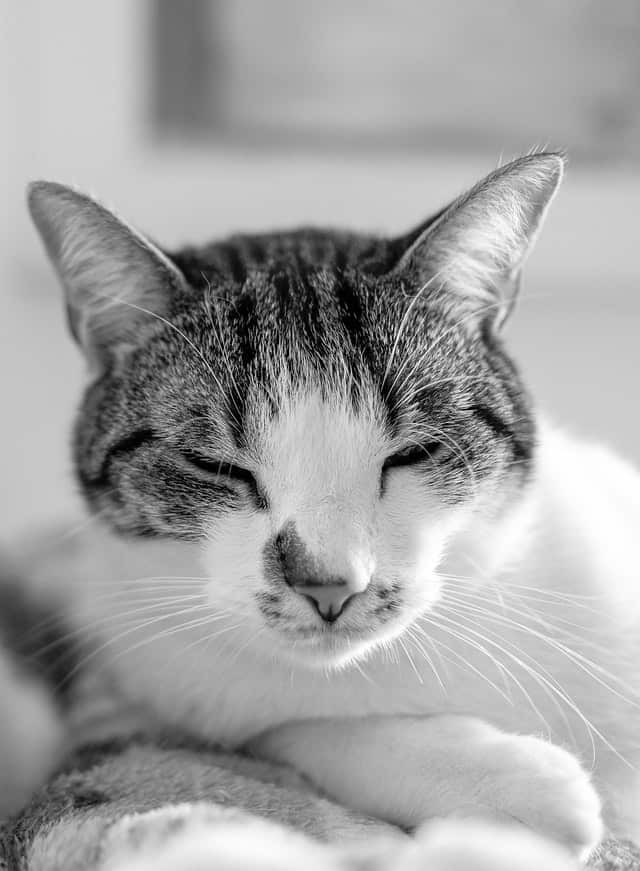
If while we pet it we notice some strange black spots on the cat’s nose, or on its lips, it could be the sign of some problem.
When our cat shows black or brown spots on the lips, nose and near the eyes, we could certainly worry, as we often do not know what they are and if they are threatening or not. They are actually harmless and the reason they appear is usually the so-called lentigo simplex, a genetic condition common in orange, tabby (striped), flame, tortoiseshell and calico (tri-colored) cats. Often these spots, real freckles, appear when the cat is now middle-aged or elderly, but there are cases of cats in which they begin to appear at one year of age.
Worry or not?
We usually notice in these cases of lentigo simplex the black spots on the cat’s nose first, and we begin to worry even more if more spots appear or if some grow in size. Usually the cat has a single lesion or a small series, and this is precisely the characteristic of this pathology.
On the other hand, when more lesions appear in the area, in large numbers, we will have the so-called profuse lentigo. Some cats may also be prone to freckles. If our cat falls into this category, we should expect that as it ages more freckled lesions will appear.
Small lesions of a millimeter or less may appear close together, making an area up to 10mm wide discolored. These lesions appear flat, do not itch or cause pain, and do not have redness or other discoloration. If our cat has these lesions on the face it is likely that he also has them elsewhere, such as on the eyelids or on the palate.
Injuries and freckles
Lentigo lesions are not freckles, and are distinguished from this type of spots by their darker color, sparse distribution, and some scarcity. Furthermore, unlike freckles, they do not increase or darken when exposed to the sun; but despite this we always remember that excessive exposure to the sun can cause burns in cats that could lead to melanoma of the skin.
These dark spots on the cat’s nose are the result of melanocytes (pigment-producing cells), which produce more melanin than the skin cells around them. There is no known reason why some cats have a genetic predisposition to lentigo, but it appears to be more common in orange colored cats (occasionally, silver and cream colored cats may also have lentigo, however).
Lentigo and cancer: differences
As we said at the beginning, lentigo is harmless. It is not in fact a form of cancer, freckled spots do not become melanomas over time, it is totally harmless just like human freckles and no medical treatment is needed. No reason to worry, then.
Obviously though, it cannot be assumed that every single dark spot is harmless, but let’s talk about the most common scenario. In fact, lentigo may hide melanomas, and dark spots are certainly more likely to be cancerous than flat spots. So, just to rule out any more serious problems, we have our cat checked by the vet so as to be safe.
Even in the case of each new discovery of spots on the cat, it is worth checking these spots with the vet, especially if the spots are inflamed, raised, or bothersome to our cat. There are several more serious conditions on the nose and lips of felines, which should be checked for any possible disease.
When to worry

Lentigo, we have already pointed out, is not a medical problem, but cats can develop skin cancers (melanomas) and we must therefore check if a black spot is a freckle or something more serious. The most common – albeit still rare – form of cat melanoma occurs in the iris, the colored part of the eye. These tumors may appear as dark patches on the side, usually occurring in only one eye, not both. These spots can indicate cancer, but they could also be benign. The best is always a visit to our vet.
In addition to melanomas, cats can develop tumors in various organs, some of which may be cancerous: they are also rare, but they are often fatal. In general they are accompanied by symptoms such as lethargy, lack of appetite, drool. Unfortunately, these symptoms do not always occur, so on every occasion that may cause us concern (a lump, a bump, a different behavior than usual) always contact our veterinarian.






